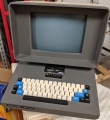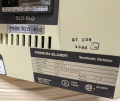Perkin-Elmer Bantam 550
| Perkin-Elmer Bantam 550 | |
|---|---|
 | |
| Manufacturer | Perkin-Elmer |
| Model | Bantam 550 |
| Lifetime | |
| Introduced | October, 1978 |
| Introductory Price | $966 |
| Communication | |
| Interfaces |
RS-232C, (Optional) 20mA current loop |
| Baud Rates | 110, 200, 300, 600, 1200, 1800, 2400, 3600, 4800, 7200, 9600 |
| Character Modes | |
| Resolution | 80x24 |
| Matrix | 7x10 |
The Perkin-Elmer Bantam 550 terminal was introduced in October, 1978 at a price of $966.[1][2] In 1981, several variations of the Perkin-Elmer Bantam 550 were introduced: [3]
- Model 550S offered block mode editing and an optional second page.
- Model 550E offered a numeric data entry keypad.
- Model 550B offered reduced price and high reliability through the use of custom LSI chips.
Features
- 12" CRT display (80 characters by 24 lines)
- switchable white-on-black or black-on-white display
- upper and lower case characters (formed by a 5-by-9 dot matrix within a 7-by-10 dot field to allow for lower case descenders). The cursor is displayed in reverse video as a block.
- 110, 200, 300, 600, 1200, 1800, 2400, 3600, 4800, 7200, 9600 baud rates
- 25pin (male) RS232 port
- silent (no fan) operation
According to the advertisement the "crisply styled Bantam measures only 15" wide, 19" deep and 14" high, and weighs a mere 28 pounds" (approx 38cm, 48cm, 36cm and 13kg). Power supply is rated 230V @ 0.375A (= 86.25W).
Available options
Prices from 1979 catalog. [4]
- anti-glare etched grey (30 USD) or green (60 USD) CRT
- full overstrike APL model
- audible alarm (30 USD)
- foreign/international character sets (75 USD)
- current loop interface (80 USD)
- RS-232C "wye" printer interface (25-pin female) (80 USD)
- Universal 100/115/230V 50-60Hz power supply (1055 USD (whole machine))
Printer interface
An optional auxiliary output interface port which is located on the rear panel of the terminal used for the connection of a local output device. The port is unidirectional and is intended to interface serial devices adhering to EIA standards. Depressing the latching PRINT key connects serial data from the host computer to the auxiliary output interface port via a "wye" connection.
Keyboard
A data entry-style keyboard with embedded 12-key numeric keypad (including comma and period). Key functions include Line Feed, Carriage Return, Backspace, Tab, Repeat, Clear, Print. Numeric Only, and Upper Case. The keyboard generates all 128 ASCII character codes. Character repeat occurs at a rate of 15 cps when a key is held down. International character sets for French, Swedish, Danish/Norwegian, German, British, and Spanish are optionally available.
The keyboad is made by Hi-Tek and appears to use their High Profile, "Waffle frame, colourless" switches.
Controls
- Mains power switch is located under the display hood, on the right.
- Display brightness control is on the left side under the display hood.
- On top of the keyboard is a small sliding door which houses the user adjustable switches (baud rate selector, transparent mode switch and 9 DIP switches)
- Behind the baud rate slider and DIP switches, four coloured potentiometers can be seen, but they are not marked. Anyone know what they do (presumably they are CRT adjustments)?
- TRANSPARENT MODE displays both data characters and control characters, but does not execute control sequences. In this mode only, the terminal provides automatic carriage return and line feed functions at the end of each line. When the 24th line is filled, displayed data is moved up one line as each new line is entered, causing the first line to scroll off the display.
There are four latching control keys on the top of the keyboard:
- NUM ONLY enables the embedded numeric keypad
- U/C upper case only
- PRINT routes data from the communications port to the auxiliary printer port
- LINE key places the terminal in the on-line mode to receive or transmit data via the communications lines. In off-line mode, the terminal displays only the data entered at the keyboard.
DIP switch settings
- 1 and 2 set the parity:
- off - off -> ODD
- off - on -> EVEN
- on - off -> MARK
- on - on -> SPACE
- DIP 3
- on: 1 stop bit
- off: 2 stop bits
- DIP 4
- on: 50 Hz
- off: 60 Hz
- DIP 5
- on: inverse video
- off: standard video
- DIP 6 (only in terminals with the optional current loop interface)
- on: -12v
- off: open
- DIP 7 (only in terminals with the optional current loop interface)
- on: +12v
- off: open
- DIP 8
- on: half duplex
- off: full duplex
- DIP 9
- DTR high, off
- DTR controlled by the LINE switch
Unix terminal code for the 550 is "pe550"
Images
References
- ↑ "Decoding, CRT Control Logic Combined in Terminal's Chip", Computerworld, October 23, 1978, pg. 35
- ↑ Perkin-Elmer advertisement, Computerworld, July 14, 1980, pg. In Depth/6
- ↑ Perkin-Elmer advertisement, Computerworld, February 9, 1981, pg. 73
- ↑ [1], Perkin-Elmer Display Terminals catalog and price list (1979) PDF
































